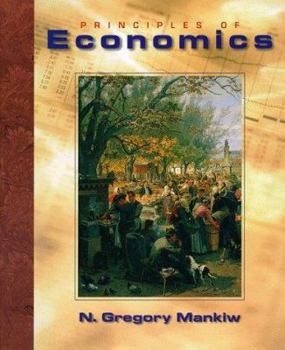Principles of Economics
Select Format
Select Condition 
Book Overview
Now you can master the principles of economics with the help of the most popular, widely-used economics textbook by students worldwide -- Mankiw's PRINCIPLES OF ECONOMICS, 8E. With its clear and... This description may be from another edition of this product.
Format:Hardcover
Language:English
ISBN:0030982383
ISBN13:9780030982385
Release Date:August 1997
Publisher:South Western Educational Publishing
Length:850 Pages
Weight:4.10 lbs.
Dimensions:1.3" x 8.8" x 10.3"
Customer Reviews
3 ratings
A beautiful introduction
Published by Thriftbooks.com User , 15 years ago
This was the textbook (in an earlier edition) that introduced me to economics back in high school. I decided to take the AP exam in the subject, even though my school offered no such course. Between this text and a test prep book, I was able to ace the exams; but more importantly, I was immersed in a subject so fascinating that I'm now studying it as a PhD student. Throughout the book, Mankiw highlights differences in opinion between economists and "laymen," and to examine where those differences come from. For instance, rent ceilings are a popular policy that 93% of economists (as of a 1992 survey) say "reduce both the quantity and the quality of available housing." Mankiw explains why economists are so sure of this in compelling, intuitive terms, without demanding that students master calculus or statistical methods. Interested students should also subscribe to Greg Mankiw's excellent blog to keep up with the latest news in the ever-evolving field of economics.
A fine introductory text for students and generalists
Published by Thriftbooks.com User , 20 years ago
This is a very readable textbook for undergraduates or interested generalists who want to develop a basic understanding of economics. Dr. Mankiw focuses on developing intuitions and habits of thought rather than teaching mathematical techniques. He does this by using ten basic principles that he lays out in the introduction. Throughout the book, whenever one of the ten principles is discussed he uses a special symbol in the margin to draw attention to that discussion. The book's thirty-six chapters are divided into thirteen parts. The first two parts introduce the ten principles and the basic ideas of supply, demand, and markets. Parts 4-7 discuss topics in microeconomics including the areas of current research. Parts 8-13 discuss topics in macroeconomics and conclude with five debates over macroeconomic policy. Since this is a general textbook the author really does not come down hard in one school of economic thought or another. Conservatives, like me, might find him a bit more accommodating of the role of government in society than we would think healthy. However, he is far from being a Keynesian or a New Keynesian. In fact, his discussion of the Phillips Curve has brought him under attack in some circles. I feel that his trying to develop an intuition of the tradeoff economies face when trying to pursue employment and price stability is understandable and, on balance, helpful to young students and generalists. Let them wrestle with the more advanced arguments after they develop their facility with the tools of economics. The book does have a glossary, an index, and inside the back covers there is a list of a couple dozen books for summer reading. This is not a one-volume compendium of economic thought for your bookshelf. It is a textbook for those who wish to develop a basic understanding of economics through general principles. If you are looking for a beginning text in econometrics, this is not the one for you. The student workbook that you can buy to supplement this text is quite good and I recommend it as well. ISBN 0-324-28859-X
The Best Introduction to Economics!
Published by Thriftbooks.com User , 25 years ago
If you read only one book on economics, read this. It deals clearly and concisely with the substance of economics and with the economists' approach -- an approach that far too few people appreciate, and which this book will instil in you. Claims that the book does not have enough math and does not cover Keynesian macroeconomics are misguided. Regarding the supposed lack of math, one must remember that math is merely a tool that should be used to clarify and not confuse economics. If one can explain economics in English, so much the better. Economics needn't be hard. Mankiw's economics is at least as good as the best of the harder and more mathematical textbooks, and better than the rest. The need is for good economics to be explained well to a large audience, and this book does it superbly.Regarding the exclusion of Keynesian short run macroeconomics, all I can say is "Whew! Finally! At last!". Keynesian short run macroeconomics taught at the undergraduate level is mindless, unintuitive curve pushing and generates neither understanding nor love for the subject. Teaching that (especially in a first course to a general audience!) is absolutely unforgivable. If anyone is married to Keynesian economics, they can use Mankiw's "Macroeconomics" which covers with exceptional clarity and brevity all the standard material in an intermediate macro course including the ugly Keynesian short run macroeconomics. However, I am against such an approach. The proper way would be to do Mankiw's "Principles of Economics" in the introductory course and then cover the market-clearing approach to macroeconomics of Barro's "Macroeconomics" in the intermediate macroeconomics course.






